When it comes to working out, most of us dream about sporting a set of strong chiseled biceps. Not only are they one of the most noticeable muscle groups, giving off that fitness-buff vibe, but they’re also a powerhouse when it comes to lifting and pulling stuff. Rocking solid biceps means you’ve got serious upper body strength, and let’s be honest, they look great too.
But here’s the deal, you’ve got to know your biceps inside out to train them right. Your upper arm houses the bicep muscle group which is made up of two main stars; the biceps brachii and the brachialis. The biceps brachii, true to its ‘bi-ceps’ name, is split into the long head (adding that oomph to the outer arm and the peak of your bicep) and the short head (residing on the inner arm). Then you’ve got the brachialis lying beneath, pitching in for elbow flexion and beefing up the overall size of your upper arm.
The secret to sky-rocketing your bicep gains isn’t just about repping out endlessly, it’s all about shaking things up in your workout. Just like any other muscle, your biceps crave a bit of variety – hit them from all sides and mix up your exercises to keep them guessing and growing. By keeping things fresh, you’re working all the different areas of your biceps and surrounding muscles, which means you’re nailing a well-rounded approach to your bicep game. In this article, we’re going to delve into six dynamite bicep workouts that will infuse some excitement into your routine and lead to some serious muscle growth and definition.
Warm-up Exercises
Warm-up exercises are an indispensable part of any effective fitness routine. Engaging in a proper warm-up before diving into your biceps workout is crucial for a few reasons. Firstly, it raises the body’s temperature, which enhances muscle elasticity, reduces the risk of strains, and helps improve performance. Secondly, a warm-up increases blood flow to the muscles, supplying them with more oxygen and nutrients necessary for high performance. Lastly, it prepares your mind for the upcoming workout, helping to focus your attention on the muscles you’re about to train.
When it comes to bicep workouts, warming up the upper body, particularly the arms, is essential. A good warm-up exercise for your biceps workout could be light-weight dumbbell curls or resistance band curls. These exercises help stimulate the biceps and the surrounding muscles without causing fatigue.
Begin with light weights and aim for 15-20 repetitions for two sets. This will help activate your biceps and prepare them for the more intense workout ahead. If you’re using resistance bands, perform the curls in a slow, controlled manner to make sure all muscle fibers are engaged.
Another excellent warm-up exercise is arm circles, which, while simple, can effectively increase blood flow in the arm, shoulder, and chest area. Remember, the goal of your warm-up is not to tire your muscles but to prepare them for the workout. Always listen to your body during warm-ups and ensure you are adequately prepared before you jump into your biceps workout.
6 Powerful Biceps Workouts
1. Barbell Curls
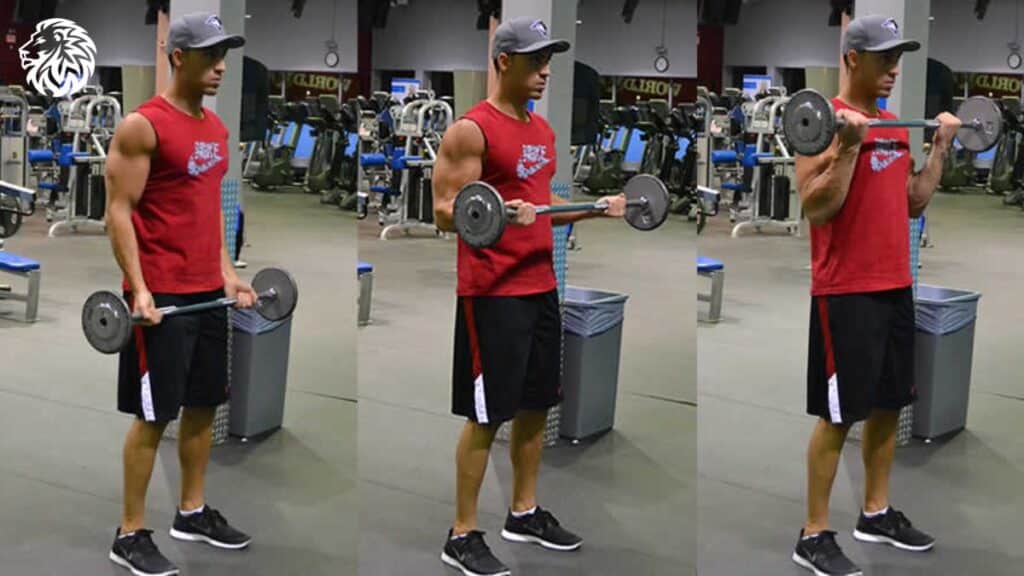
Barbell curls are a classic bicep-building exercise. The exercise is performed by holding a barbell with both hands, palms facing forward, and lifting it by flexing the elbows while keeping the upper arms still.
The benefits of barbell curls are manifold. They target both the long and short heads of the biceps, allowing for overall muscle development. Moreover, because barbell curls involve a relatively heavier load than other exercises, they are effective for building strength as well as size.
To perform barbell curls correctly, stand straight and grip the barbell shoulder-width apart. Keep your elbows close to your body and your upper arms stationary. As you curl the weights, breathe out and contract your biceps. Make sure to lift the weights using only your forearm and not your back or shoulders. A common mistake is to sway or use body momentum to lift the weights, which can lead to potential injuries and lesser engagement of the biceps.
2. Hammer Curls
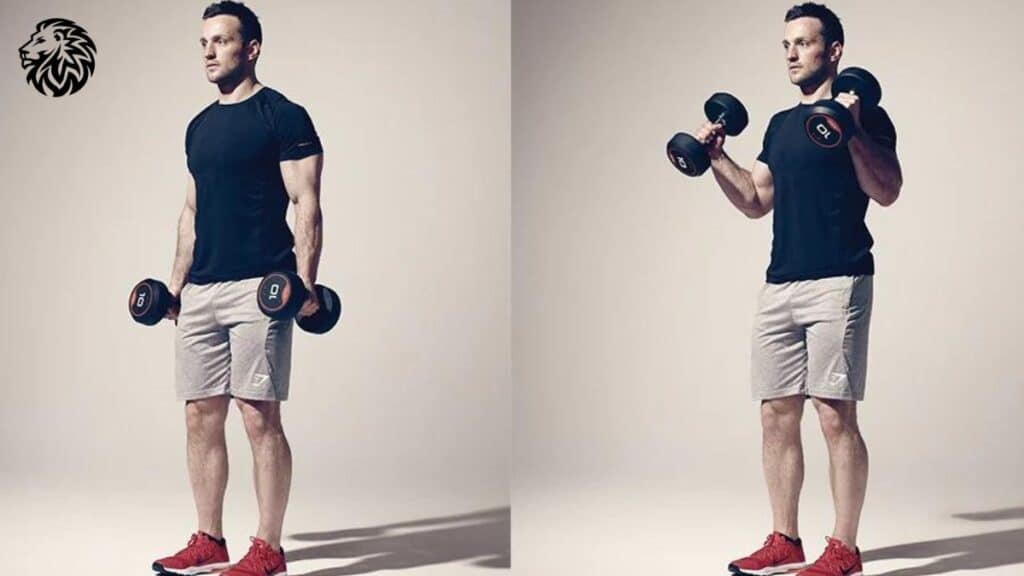
Hammer curls are performed with a pair of dumbbells. Unlike traditional curls, your palms face each other during hammer curls, mimicking the action of hammering. This small change in grip helps target different parts of your upper arm.
The primary benefit of hammer curls is that they target the brachialis and the brachioradialis, a muscle of the forearm, in addition to the biceps brachii. This leads to an increase in the overall size of the arm and enhances the peak of the bicep, making your arms look bigger and more defined.
To perform hammer curls, start by standing straight, holding a dumbbell in each hand with your arms fully extended, and palms facing your torso. Keep your elbows close to your body and your upper arms stationary. Curl the weights while keeping the palms of the hands facing each other until your biceps are fully contracted. One common mistake is to not fully extend the arm at the bottom of the movement or not contracting the bicep at the top. Both actions are important to ensure full muscle fiber recruitment.
3. Concentration Curls
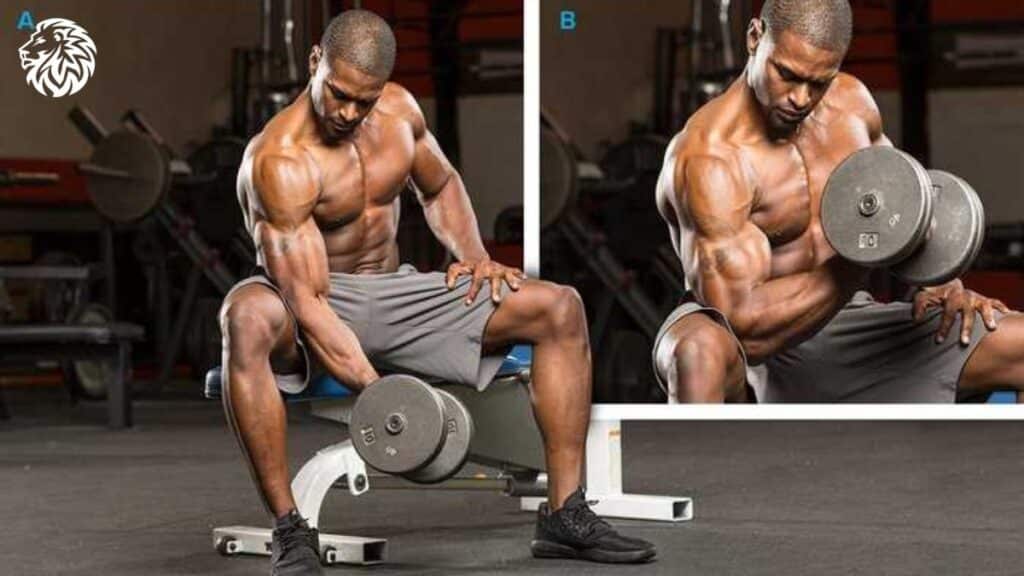
Concentration curls are a bicep isolation exercise performed with a single dumbbell. Unlike other bicep exercises, concentration curls are usually performed sitting down with the arm working against gravity, providing a constant tension on the biceps.
The main benefit of concentration curls is the high degree of isolation of the biceps brachii. This allows you to specifically target the biceps without the aid of other muscles, ensuring they receive a high-quality stimulus for growth. Concentration curls are also great for improving the muscle’s peak due to the intense focus on the biceps brachii.
To perform concentration curls, sit on a bench with your legs spread and a dumbbell between them. Bend over and grab the dumbbell with your palm facing upward, and the back of your upper arm resting against your inner thigh. Curl the dumbbell towards your chest, keep your upper body still, and avoid using your shoulder or back to lift the weight. A common mistake is to lift the weight too fast, causing a loss of control and reduced muscle engagement. Ensure to maintain a slow and controlled motion throughout the exercise.
4. Preacher Curls
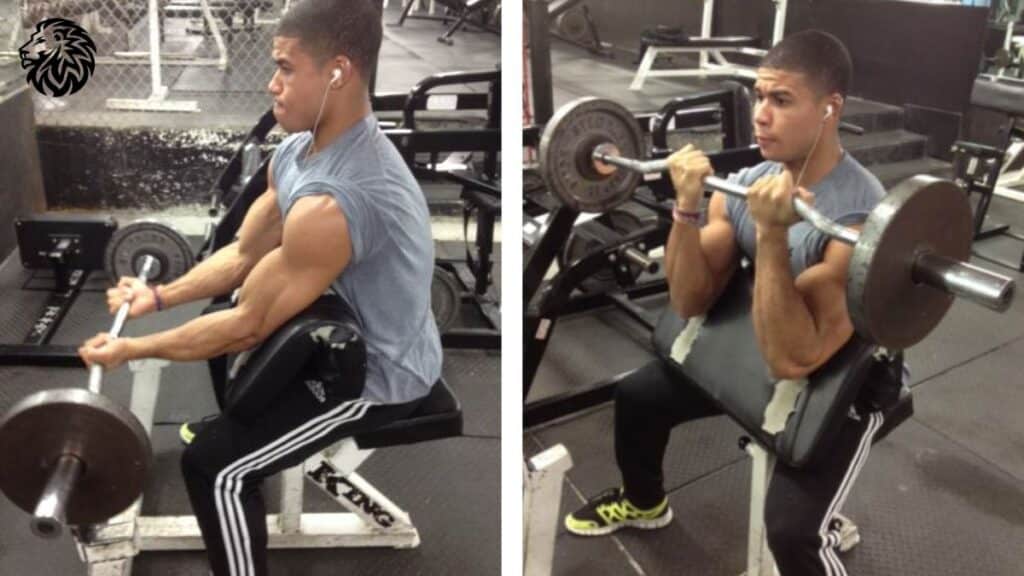
Preacher curls are performed with a barbell or dumbbell and a preacher bench, a piece of gym equipment designed to isolate the biceps by eliminating the use of the shoulders and back in the movement.
The main benefit of preacher curls is the high level of bicep isolation they provide, just like concentration curls. They also ensure constant tension on the biceps, even at the bottom of the movement, which can contribute to increased muscle growth. Preacher curls are particularly effective for targeting the lower portion of the biceps, helping to develop a fuller, more rounded look.
To perform preacher curls, sit on a preacher bench and rest your upper arms on the pad, fully extending your arms. Grab the barbell or dumbbells with an underhand grip, then curl the weight up, squeezing your biceps at the top. Lower the weight back down until your arms are fully extended, maintaining control throughout the movement. A common mistake is to not fully extend the arms at the bottom of the exercise or to use momentum to lift the weight, which can lead to reduced muscle engagement and potential injury.
5. Incline Dumbbell Curls
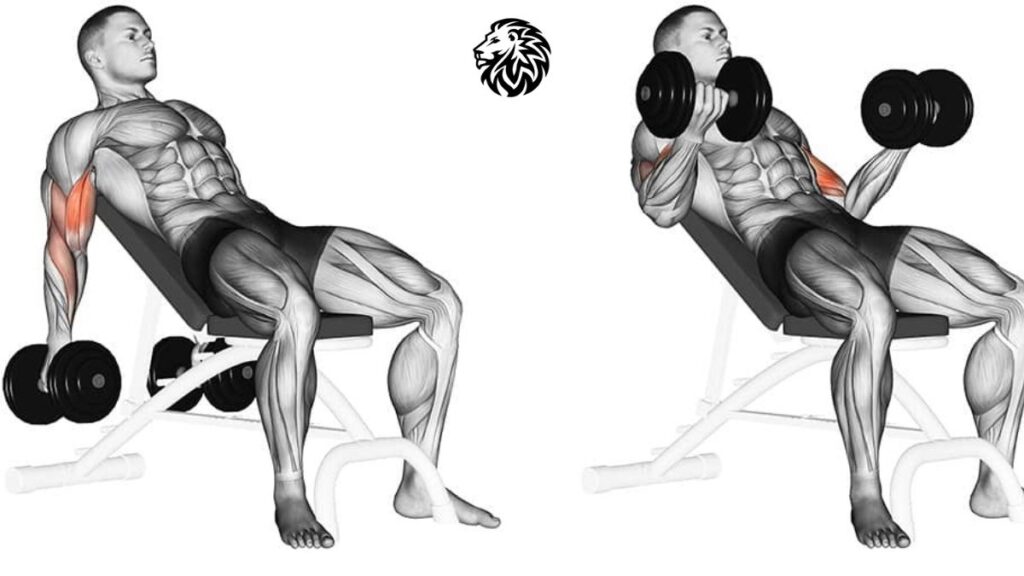
Incline Dumbbell Curls are a variation of the traditional bicep curl, performed on an incline bench. This position provides a unique angle that increases the range of motion and puts additional emphasis on the biceps.
One of the primary benefits of Incline Dumbbell Curls is the increased stretch they put on the biceps, particularly on the long head of the bicep. This stretch can lead to greater muscle activation and growth. Additionally, because each arm works independently, any muscle imbalances between your left and right bicep can be addressed.
To perform Incline Dumbbell Curls, lie back on an incline bench holding a dumbbell in each hand, hanging down at arm’s length. Your elbows should be close to your torso. Rotate the palms of your hands until they are facing forward. Curl the weights while contracting your biceps as you breathe out. Make sure the upper arms are stationary, the forearms are the only part moving. Lower the weights to the starting position as you breathe in. A common mistake is to move the elbows from their position, turning the exercise into a type of hammer curl, so ensure your elbows remain fixed throughout the movement.
6. EZ-Bar Curls
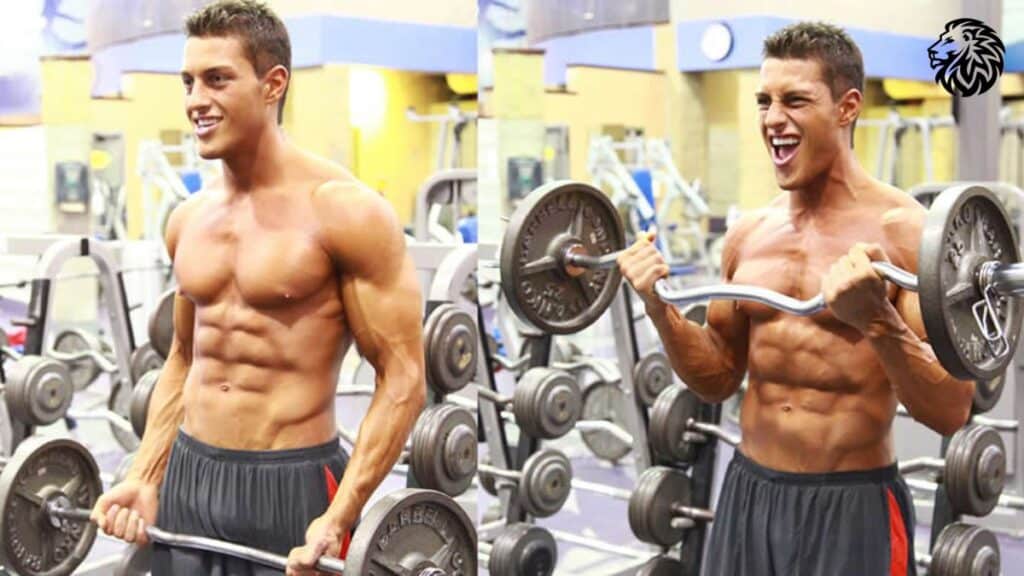
EZ-Bar Curls are performed using an EZ-bar, a special type of barbell that has a unique W shape which allows for a more neutral grip.
EZ-Bar Curls are beneficial as they target both the biceps brachii and the brachialis, contributing to overall arm size. They also allow for a more comfortable grip, which can reduce strain on the wrists and forearms, allowing you to lift heavier weights or perform more repetitions.
To perform EZ-Bar Curls, grab the outer handles of the EZ-bar with your palms facing forward. Keep your elbows close to your torso at all times. Curl the weights while contracting your biceps as you breathe out, only the forearms should move. Lower the bar slowly as you breathe in, keeping control of the movement at all times. One common mistake in this exercise is using the back or shoulders to lift the weight. This not only reduces the work your biceps do but also increases the risk of injury, so ensure your upper body is stationary throughout the movement.
Safety Measures and Tips
Safety Measures to Avoid Injuries
When performing any form of exercise, safety should always be a top priority to avoid injuries. In biceps workouts, some safety measures include:
- Never skip the warm-up: As discussed earlier, a good warm-up enhances muscle elasticity and reduces the risk of strains and sprains.
- Maintain good form: Proper form is crucial in any exercise to ensure the right muscles are targeted and to prevent injuries.
- Use appropriate weights: Lifting weights that are too heavy can lead to poor form and possible injury. Start with lighter weights and gradually increase as your strength improves.
- Don’t rush: Fast, uncontrolled movements can lead to muscle strains. It’s better to perform movements slowly and controlled to ensure maximum muscle engagement and prevent injuries.
- Rest between sets: Allowing your muscles to recover between sets prevents muscle fatigue, helping you maintain good form throughout the workout.
Tips to Improve Form and Maximize Benefits
- Mind-muscle connection: Try to really focus on the muscle you are working on. This connection can lead to greater muscle activation and more efficient workouts.
- Full range of motion: Always aim to use a full range of motion in your exercises. This ensures that you work the muscle through all its lengths, leading to more balanced muscle development.
- Variety: Mix up your workouts to prevent your muscles from adapting to a specific movement pattern. This can keep your muscles growing and prevent plateaus.
- Consistency: Keep a regular workout schedule. Consistency is key for muscle development.
The Importance of Listening to Your Body During Workouts
While it’s important to push yourself during workouts, it’s equally crucial to listen to your body. If a movement causes sharp or unusual pain, it’s a sign that something isn’t right. It’s better to stop and assess than to push through and risk injury. Also, be mindful of your body’s fatigue levels. Overtraining can lead to decreased performance and increased risk of injury. If your body is asking for rest, give it time to recover and rebuild. Remember, fitness is a marathon, not a sprint. Patience and persistence will lead to progress over time.
Importance of Rest and Nutrition
Role of Rest in Muscle Growth and Recovery
Rest is a vital component of any successful fitness program. Rest plays a significant role when it comes to muscle growth and recovery. During rest periods, especially sleep, our bodies repair the microscopic damage caused to the muscle fibers during workouts, which leads to muscle growth. This process is known as muscle protein synthesis. It’s during this time that the muscles grow larger and stronger.
Furthermore, adequate rest helps prevent overtraining syndrome, a condition characterized by a decline in performance and physiological function due to excessive training. Overtraining can lead to a plateau in muscle growth, increased risk of injury, and decreased immune function. Hence, ensuring you have enough rest in between workouts and incorporating rest days into your routine is critical for optimal muscle growth and recovery.
Feeding Your Muscles Right
Good nutrition is like fuel for your muscle growth engine. Without the right food, your body won’t have the stuff it needs to fix and grow those muscles. Here’s a peek at the kind of diet that muscles love:
- Protein: These are your muscle’s best buddies. They break down into amino acids that your body uses to repair and build muscle. So, fill up your plate with lean meats, fish, dairy, eggs, and don’t forget the plant proteins like beans and tofu.
- Carbohydrates: Carbs provide the energy your body needs to perform intense workouts. Include complex carbs like whole grains, fruits, and vegetables in your diet.
- Healthy Fats: Don’t let the ‘F’ word scare you. Healthy fats like those in avocados, nuts, seeds, and fish are vital for hormone production, including testosterone, which is the secret sauce for muscle growth.
- Hydration: Water plays a crucial role in every bodily function, including muscle recovery. Ensure you’re staying adequately hydrated, especially around workout times.
- Micronutrients: Vitamins and minerals are needed for various metabolic processes, including muscle recovery and growth. A balanced diet rich in a variety of foods can help ensure you get these necessary nutrients.
- Timing: When you eat can be as important as what you eat. Consuming a protein-carb snack or meal after your workout can maximize muscle repair and growth.
Remember, everybody is unique, and so are their nutritional needs. So find what fuels your body best. And when in doubt, a registered dietitian or a nutritionist can be your guide.
Conclusion
In this article, we explored six powerful workouts to help develop and strengthen your biceps. These exercises included:
- Barbell Curls: A classic bicep exercise that targets both the long and short heads of the biceps, contributing to overall muscle development and strength.
- Hammer Curls: These work the biceps, brachialis, and brachioradialis, contributing to a larger arm size and a more defined bicep peak.
- Concentration Curls: An isolation exercise that targets the biceps brachii, improving the muscle’s peak and overall definition.
- Preacher Curls: Great for isolating the biceps and maintaining constant tension, particularly beneficial for the lower portion of the biceps.
- Incline Dumbbell Curls: A unique angle that provides a longer range of motion and additional emphasis on the biceps, contributing to increased muscle activation and growth.
- EZ-Bar Curls: These curls target both the biceps brachii and the brachialis, with a comfortable grip that reduces strain and allows for a more effective workout.
Like any worthwhile thing in life, growing stronger, bigger biceps needs dedication, patience, and time. Remember, Rome wasn’t built in a day, and neither are muscles. Each workout takes you one step closer to your goal. So, stick to your bicep training, be kind to your body, and give it the time, rest, and food it needs to grow.
While these workouts will make a world of difference to your bicep game, remember to round it off with exercises for other muscle groups. A balanced fitness routine will not just make you look good but will also up your overall strength, posture, and body function.
Finally, remember, each fitness journey is personal. So, tune into your body, keep your form right, feed your body well, rest enough, and most importantly, have fun. Your road to powerful, chiseled biceps starts here!







